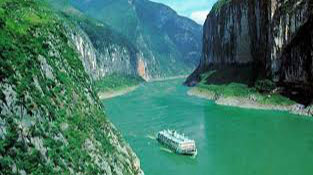Modern China has achieved many important milestones in establishing itself as an important nation of the world. It did not happen in a vacuum or by chance. Many of the accomplishments are built on the successes in the past, like a pioneer looking afar into the future landscape by standing on the shoulder of the giant of the past. China cannot accomplish as much without the foundation built in the past. Let’s examine four strengths (agriculture development, unity, development with Chinese characteristics, and ability on innovations) that are unique and fundamental to China that builds the country’s success and future.
China is an ancient civilization who established an earlier development in agriculture. Chinese civilization first emerged in the Loess Plateau near the Yellow River bank. About 5000 years ago, Chinese already had the concept of four seasons and when to plant and when to harvest as described in the ancient literature I Ching. In the Warring States period (475-221 BC), Qin kingdom built the earliest irrigation system Dujiangyan (都江堰) that transformed the Chengdu plain into a futile agriculture powerhouse. In the south along the Yangtze Delta, earlier settlers (around 3600 BC) learnt how to grow silkworms to produce silk and make clothing. By Tang Dynasty (618-907 AD), farmers grew the mulberry trees (leaves fed to the silkworms) near the fish ponds and formed a renowned sustainable ecosystem (called mulberry-dyke fish-pond) that produced multiple products including silk fabrics and fishes. China is also a large country with very little arable land. Around the Tang Dynasty, the Hani tribes in Yunnan province started building rice terraces on the hill side. Fast forward to the 60s, “farmers in Henan province hand built a 1500 km long aqueduct called red flag aqueduct (红旗渠) on the shear cliff of Taihang Mountains for providing the water to their mountainous villages and farm lands. Nowaday, farmers are building green shelter belts and straw checkered lands to fight against and get lands from the encroaching Taklimakan Desert in Xinjiang and Gobi Desert in Inner Mongolia autonomous region. All these examples show the wisdom and innovation of Chinese people and their determination and perseverance when they are facing challenges. They form the foundation of their modernization drive and innovation.
China has similar land and population size as continental Europe. But what held China as one country “while Europe fell into a continent with endless wars and many regions fighting for independence? China also has a long history with 24 different dynasties. Chinese always believe that a country once divided would become united. They weigh unity higher than the other criteria. There are at least four reasons supporting their belief.
- 1. Chinese believe they all share a common culture and history.
- 2. China was ruled many times by nomad tribes other than the Han. But the nomad tribes ruled with the same systems invented by the Han, like the country governance system, the the social hierarchy and family relationship, and the moral standard based on Confucious teaching. In other words, the nomad tribal cultures were mixed in and merged with the Han’s culture. So the resulting culture became more diversified and inclusive to all the tribes.
- 3. In Chinese society and history, there is no forever superior race. Chinese of different races are treated fairly and equally. So there is no racial reason to be independent from the Chinese nation.
- 4. Chinese civilization started in the Loess Plateau and Yellow River basin (called Central Plains中原). When Chinese escaped wars and migrated to different regions, they still maintained their lineage and heritage. They still saw themselves as the descendance from the Central Plains. So there was no desire for them to establish themselves as a separate nation in different regions.
Chinese are wise and resourceful. They are good planners and executors. They believe they have a long history, diversified culture, and unique circumstances. They would not hesitate to resolve problems in their own way. They started that when they first established their new nation from scratch in 1949. They fought for their survival during the Korean War. They built their industries and agriculture under the sanction from the US and in the midst of aid redrawal from the USSR. They developed their nuclear deterrence and the first satellite all on their own efforts and resources. So it is quite natural to start the modernization on a separate path not following the West. They planned out their own development path and made necessary reforms to overcome any major obstacles. It turns out the modernization was so successful. They managed to rise from a poor country to a middle income country peacefully without accruing that much debt. They will maintain their approach and the development path in the foreseeable future.
The Chinese had many ancient innovations. If you compared the years of invention with the West, their innovations were ahead of the West. But in the Qing dynasties, China became isolated and fell behind the West in technology. The country, since its founding, was a student learning from the West on many aspects including technologies. Since 2015, the country has raised its innovation game and become more like a teacher. It leads the world in patents filing, the number of graduates and researchers in the STEM fields. It is a front runner in infrastructure, and manufacturing. It also leads the world in many advanced technologies, like EV, green technologies, Robotics, and ties with the US on AI, Quantum Computer, Human Computer Interface, and Biotechnology. Their innovations in technology are real, magnificent, and sustainable. Like their ancestors in history, the current and future generations of Chinese will make great contributions to mankind.




